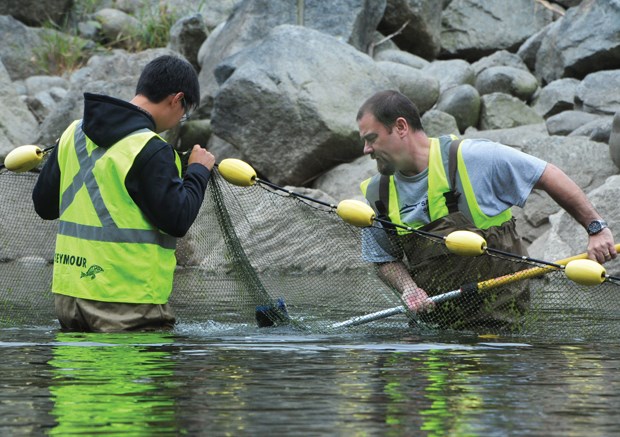Thousands of migrating coho salmon waiting in Burrard Inlet at the mouths of the Capilano and Seymour rivers have two choices in the face of unseasonable conditions: head upstream into 20 Celsius waters and likely perish or take their chances in the cooler ocean and be vulnerable to predators.
Low water flows and high temperatures in the North Shore’s major rivers and salmon spawning channels are delaying the return of the fish, according to Seymour Hatchery manager Brian Smith.
Temperatures have hit 20 C in lower portions of the Seymour River when ideally they should be in the 11 to 15 C range for this time of year. Closer to the mountains, where the Capilano River joins Capilano Lake, water temperatures were also averaging 20 C this week.
“The warmer the water gets the less oxygen that’s available for the fish,” explained Smith. “They will be waiting for the rain and the temperatures to come down and then they will start making their move.”
While waiting to enter the streams, said Smith, the salmon are susceptible to recreational fishing and predators such as eagles. This summer Smith is expecting approximately 3,600 coho and 500 steelhead salmon to return to the Seymour River.
The recent dry spell and warm weather shouldn’t affect the number of returning salmon, said Smith, but this interference during the spawning reason could result in fewer fish coming back next year.
Metro Vancouver plays a role in the successful return of the salmon as it controls water flow coming off the dams at the Seymour and Capilano reservoirs. The average water flow in the Seymour River last June was 9,481 litres per second, compared to a startling 1,730 litres per second this past June.
Why the water levels are unseasonably low can be blamed on the balmy conditions the Lower Mainland has experienced since the wintertime.
“It’s a combination of things,” said Bob Cavill, Metro Vancouver watershed division manager. “We had very limited snowfall this year. It was about eight per cent of an average typical year — so that was a problem. Then it was followed by very limited rainfall through the spring season. And then compounding it is very hot temperatures.”
As the region is currently facing a water shortage in its reservoirs, it’s becoming a bit of a balancing act for water officials to protect the supply and the fish stocks at the same time.
“Our objective is to provide sufficient supplies of drinking water and to do what we can to make sure the required fish (water) flows below the dams are met as well,” said Cavill. “We are experiencing a challenging situation this year for sure in terms of water supply.”
Metro Vancouver is assessing the water flow situation on a weekly basis with the Department of Fisheries and Oceans, which sets out the guidelines as it relates to fish habitats, in case adjustments need to be made. In the Seymour River the DFO has allowed flow rates to be reduced, unless weather patterns change, until mid-September to preserve drinking water.
A multi-government partnership to protect fish population potentially impacted by a massive rock slide in the Seymour River last December is currently underway.
The rock slide dumped 50,000 cubic metres of granite into the river — a spawning habitat for salmon and steelhead trout — creating a permanent lake and a series of waterfalls — effectively a fish barrier — likely changing the Seymour River’s viability as fish habitat, the DFO said in December.
To help the adult coho, steelhead and pink salmon along they will be trapped in the river below the Mount Seymour Parkway Bridge and then some will be transported in trucks and trailers to the Seymour Hatchery while others will be released into their normal spawning habit above the slide.
The estimated $100,000 project is a partnership between the Tsleil-Waututh Nation, Squamish Nation, Seymour Salmonid Society, Metro Vancouver, the DFO, the District of North Vancouver and the province. Thirty of the trapped adult coho will be radio-tagged so officials can see if the fish make it past the rock slide and determine if there’s a barrier to adult salmon migration.
In West Vancouver a salmon stewardship program is keeping a close eye on the dry conditions in the dozens of creeks and tributaries.
“Although the waters are extremely low they are not doing too badly,” said West Vancouver Streamkeepers president John Barker. “We have got no evidence of fish in distress.”
Salmon are resilient, explained Barker, and will do what they can to survive by getting down into the nooks and crannies of the creekbeds. The streamkeepers are closely monitoring Brothers Creek and Hadden Creek where water levels were down by 38 per cent in June when compared to August 2014. More than 1,000 salmon return to those creeks every year.
“I haven’t seen the waters this low but these poor fish they have to survive floods and droughts,” said Barker. “This is their world, this is their reality in our local urban streams.”



